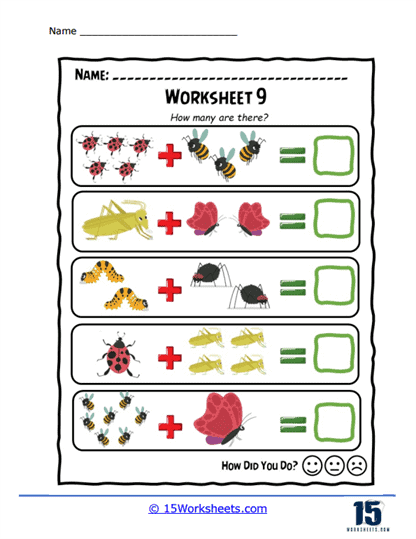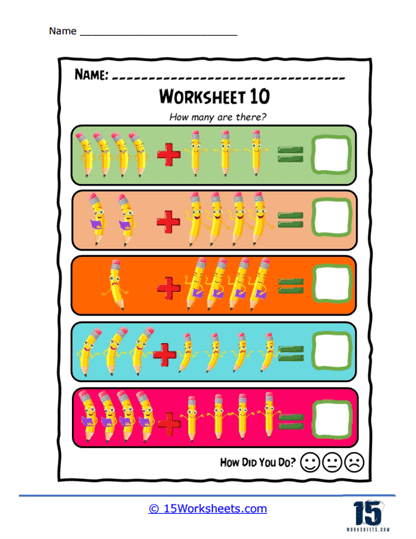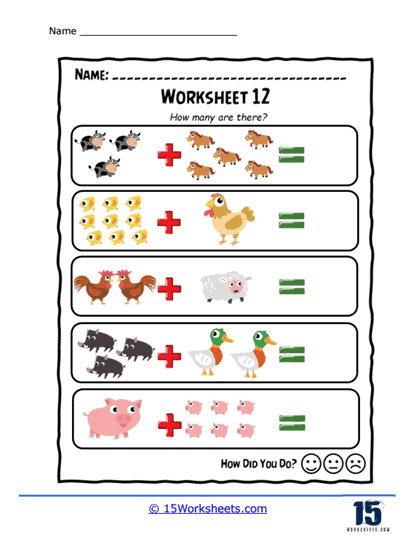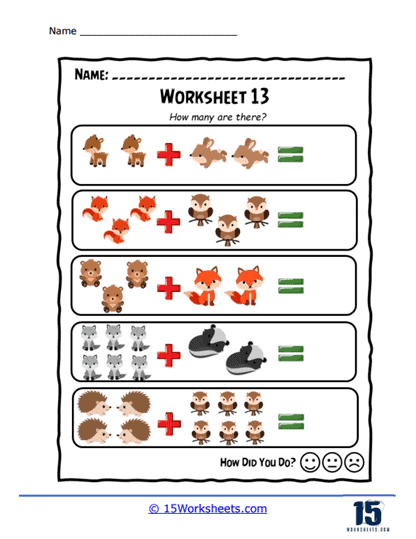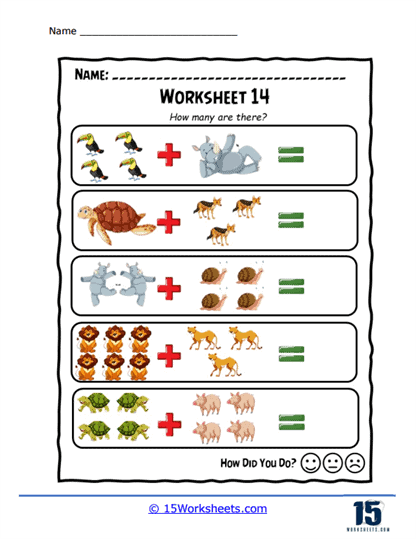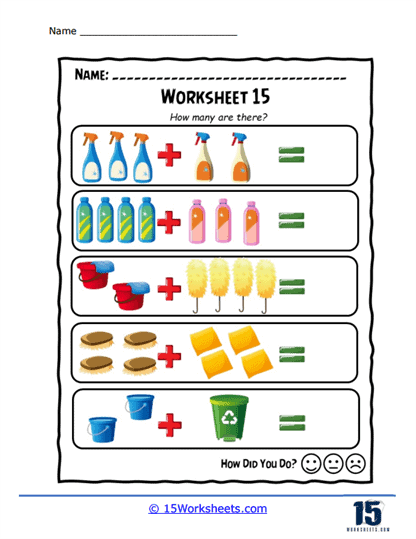Picture Addition Worksheets
About These 15 Worksheets
Introducing students to the foundational concept of addition is a pivotal step in their mathematical development. In these formative years, children are often grappling with abstract ideas for the first time, and the transition from the concrete world of objects they can see and touch to the abstract world of numbers can be challenging. These carefully designed worksheets serve as an essential tool in making that transition smoother, more intuitive, and enjoyable for young learners. By combining visual elements with numerical representation, the worksheets turn the concept of addition into something tangible and accessible, helping students not just to learn but to truly understand the process of adding.
The magic of these worksheets lies in their ability to connect with the natural way children explore and understand the world. Rather than presenting numbers in isolation, which can feel daunting, these worksheets use pictures to represent numbers. This allows children to approach addition as a familiar, hands-on activity. When a child is asked to count two groups of apples, for instance, and then combine those groups, they can physically see the process unfolding. The act of counting objects they recognize and are comfortable with—such as fruits, animals, or toys—adds an element of play to the learning process, making it both engaging and deeply effective.
The visual component is not merely a gimmick; it plays a crucial role in cognitive development. Research has shown that young learners often understand better when they can visualize the process. When students are given a set of images representing numbers, such as three bananas and four oranges, they can see how two distinct quantities can be merged into one. This bridges the gap between the physical act of counting and the abstract notion of addition. By seeing addition in action—through pictures of everyday objects—they develop a stronger grasp of what numbers actually represent. Numbers cease to be mere symbols on a page and become meaningful representations of quantities.
The use of familiar objects in the worksheets—be they animals, shapes, or everyday items—makes the task relatable and reduces the cognitive load for students. They are not only learning math, but they are doing so in a context that makes sense to them. Instead of being confronted with the intimidating prospect of manipulating numbers in their heads, they are invited to play with ideas that feel grounded in their real-world experiences. The simplicity of counting items they recognize allows them to focus on the task at hand: understanding how quantities combine to form a total sum.
This method also encourages independent problem-solving. As students become more comfortable with the idea of adding groups of objects together, they begin to develop a sense of mathematical intuition. They start to predict outcomes, experiment with different groupings, and, most importantly, build confidence in their ability to solve problems on their own. This confidence is crucial at this stage of learning, as it lays the groundwork for more complex mathematical concepts that they will encounter later on.
In addition, these worksheets foster a deeper connection between concrete and abstract thinking. The process of moving from counting objects to understanding numbers as abstract representations of those objects is a significant leap in cognitive development. The worksheets facilitate this by gradually reducing reliance on visual aids. Over time, students are encouraged to move from counting pictures to performing addition with numbers alone. This progression mirrors the natural learning process, where concrete understanding comes first, followed by abstract reasoning.
What makes this teaching method particularly powerful is that it acknowledges the different ways children learn. Some children may thrive on verbal instructions, while others may need to see and touch in order to grasp a concept. By using visual representations, these worksheets cater to a range of learning styles. Whether a child is more hands-on, visual, or logical, the act of counting objects and adding them together appeals to multiple intelligences, allowing each student to learn in the way that suits them best.
Types of Problems
Direct Counting and Summation – The most basic form where pictures are grouped, and students count each group and write down the number of items before adding them together. For instance, there might be five apples in one group and three in another, and the student will write down ‘5 + 3’ and then calculate the sum.
Matching Sums to Pictures – Students are given a series of pictures along with a set of sums. They must count the items in each picture and match them to the correct sum. This reinforces the association between the visual representation and the numerical result of addition.
Cut and Paste Activities – These are hands-on exercises where students cut out pictures and physically group them together before adding. This kinesthetic activity supports motor skills and active learning.
Color by Addition – Similar to color by numbers, this type of exercise requires students to add numbers first and then color the picture according to the sum they calculated. It’s an engaging way to practice addition and follow instructions.
Missing Addend Puzzles – Some worksheets will show pictures representing the sum and one addend, and students must figure out the missing addend. For example, if the total sum is shown to be 10 and there are 7 items pictured, students must determine that the missing addend is 3.
Sequential Picture Addition – Here, students follow a sequence of steps, adding pictures in stages and writing down each intermediate sum, which builds understanding of the additive process over multiple steps.
Comparison Exercises – These worksheets ask students to perform addition with pictures and then compare sums, identifying which is greater or if they are equal. This can extend to sorting pictures based on the sums they represent. Often, worksheets are themed around holidays, seasons, or events, which can make the addition practice more exciting and timely. For instance, a Halloween-themed worksheet might involve adding pictures of pumpkins and ghosts.
The Benefits
These worksheets can be incredibly beneficial for students in developing their understanding of basic math operation skills:
Conceptual Understanding – These worksheets help students grasp the fundamental idea of addition as putting together and increasing quantity. Visual representation through pictures makes the abstract concept of addition more concrete. As students count the items represented in the pictures, they reinforce their counting skills, an essential foundation for all arithmetic. By associating numbers with groups of items, students enhance their ability to recognize and understand numbers and what they represent.
Fine Motor Skills – For younger children, drawing lines from pictures to numbers or cutting and pasting pictures can improve hand-eye coordination and precision. Picture Addition Worksheets encourage cognitive skills such as pattern recognition, memory, and the ability to follow multi-step processes.
Problem-Solving – Students use critical thinking to determine the sum of the items pictured, developing early problem-solving abilities. Achieving correct answers through picture addition can boost a student’s confidence in their mathematical abilities, encouraging a more positive attitude towards math.
Preparation for Advanced Topics – Mastering picture addition lays the groundwork for more complex mathematical concepts, such as subtraction, multiplication, and division, which build upon an understanding of addition. These worksheets often feature colorful and engaging images, which can make the learning process enjoyable and thus increase a child’s engagement with the subject matter. Regular practice with these worksheets helps students to memorize simple addition facts, which is crucial for developing fluency in mathematics.
What Are the Benefits of Visualization?
Visualization in mathematics, particularly in the context of addition operations, offers several cognitive and educational benefits that enhance learning and understanding. Visualization refers to the use of images, diagrams, symbols, and physical models to represent mathematical concepts. This approach can significantly aid in the comprehension and application of addition, especially for young learners or those struggling with abstract numerical concepts. Here are some key benefits of using visualization in teaching and learning addition, supported by research findings:
Enhances Understanding – Visualization helps to concretize abstract mathematical concepts, making them easier to understand. By representing numbers and operations visually, students can see the relationships between numbers and understand the process of addition more clearly. Research by Sarama and Clements (2009) has shown that using visual representations can enhance young children’s mathematical understanding.
Improves Problem Solving Skills – Visual tools like number lines, base-ten blocks, and diagrams can improve students’ ability to solve addition problems by offering strategies to break down problems into manageable parts. A study by Elia, van den Heuvel-Panhuizen, and Kolovou (2009) found that visual representations can support problem-solving strategies in mathematics.
Supports Memory Retention – Visual aids can help students remember mathematical concepts and procedures better than rote memorization alone. Imagery and spatial representations are linked to better recall, as suggested by the Dual Coding Theory (Paivio, 1986). This theory posits that information is more easily recalled when it is encoded both visually and verbally.
Facilitates Error Checking and Self-correction – When students use visual methods to perform addition, they can more easily see and correct their mistakes. This immediate feedback helps in understanding the correct procedures and concepts, leading to deeper learning. Visual models help students develop a strong sense of number and the relationships between numbers. Research indicates that a solid number sense is foundational for success in mathematics (Gersten, Jordan, & Flojo, 2005).
Encourages Engagement and Motivation – Visual methods can make learning addition more engaging and interesting for students. This increased engagement can lead to higher motivation and a more positive attitude towards mathematics, as found in studies by Bobis, Clarke, Clarke, Thomas, Wright, Young-Loveridge, & Gould (2005). Visual representations can be adapted to suit diverse learning styles and abilities. They provide an alternative means of understanding for students who may not grasp concepts through traditional numerical or verbal methods alone.
Research confirms the benefits of visualization in learning addition and other mathematical operations. It’s clear that incorporating visual methods into math instruction not only helps students understand and apply concepts more effectively but also fosters a more inclusive and engaging learning environment. Integrating visualization strategies in mathematics education is a research-backed practice that enhances learning outcomes for students across different age groups and abilities.









